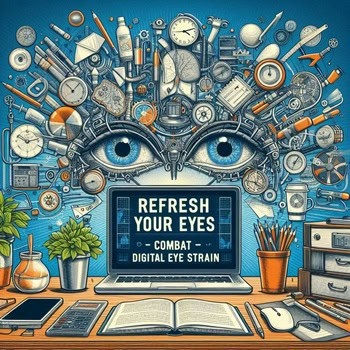Workness Series 02: Protect Your Eyes in the Digital Age
- Catherine Manin
- Mar 17
- 4 min read
Updated: Apr 19
Do your eyes feel tired, irritated, or dry after hours at the computer? Maybe your vision blurs, as if you're looking through a fog. If this sounds familiar, you may be dealing with digital eye strain, also known as computer vision syndrome.
With so much of our work and communication happening on screens, this issue has become a common workplace concern. While technology has reshaped how we function, it also puts a strain on our eyes.
This post will break down the causes of eye fatigue and share simple yet effective exercises to ease discomfort and keep your eyes healthy.

Why Your Eyes Feel Fatigue
What is Digital Eye Strain?
Digital eye strain, also known as computer vision syndrome, happens when your eyes stay focused on a screen for extended periods.
Unlike natural eye movement, which shifts between various distances, staring at a screen forces your eye muscles into constant tension, reducing their flexibility over time.
This can lead to symptoms such as:
Headaches
Eye strain
Blurred vision
Red or irritated eyes
Neck and shoulder pain
These effects are usually temporary, but if left unchecked, they can contribute to long-term discomfort.

Why Does It Happen?
Your eyes have six muscles that allow movement in all directions. However, when you stare at a screen for long periods, these muscles stay locked in a fixed position, limiting their natural movement. Over time, this repetitive strain reduces their flexibility, making it harder to shift focus between different distances.
Additionally, many office environments have dry air, which causes tears to evaporate more quickly, leading to irritation and discomfort.
The good news?
Simple self-care habits can help relieve strain and keep your eyes functioning at their best.

5 Strategies to Refresh Your Eyes
1. Blink More
Do you know that when you concentrate on your screen, you blink significantly less—about one-third as often? This reduction in blinking can lead to dry eyes and irritation. To combat this:
Take short breaks: If you start feeling eye strain, take a moment to blink several times. This will help lubricate your eyes and refresh your focus.
Be conscious of your blinking: Make it a habit to blink more frequently while working.

2. Exercise Your Eye Muscles
Just like any other muscle in your body, your eye muscles need regular exercise to stay strong and flexible.
Here are some easy exercises:
Up and Down Viewing
Focus on an object directly in front of you.
Slowly look up and then down.
Repeat this motion several times.
Sideways Viewing
Focus on an object to your left.
Slowly shift your gaze to an object on your right.
Repeat this motion several times.
Rotational Viewing
Imagine looking at the numbers on a clock.
Move your gaze around the clock face in one direction, then reverse.
Zooming/Dezooming
Hold a finger or pen about 25 cm from your face.
Focus on it, then shift your gaze to an object further away (like a wall).
Alternate between focusing on near and far objects.
Spend 5–7 minutes on these exercises twice daily—once during your shift’s first half and once after lunch.

3. Follow the 20-20-20 Rule
Combat focusing fatigue with this simple trick:
Every 20 minutes, take a break from your screen.
Look at something 20 feet away (5 m) for at least 20 seconds.
This simple practice helps relax the focusing muscles in your eyes and reduces overall strain.

4. Relax Your Eyes
Give your overworked eyes a break with these simple techniques:
Palming
Rub your hands together to generate warmth.
Gently cup your palms over your closed eyes without applying pressure.
Breathe deeply and relax for a minute or two.
Yawning
Don’t underestimate the power of yawning!
It boosts oxygen flow and refreshes both your mind and eyes. Force yourself to yawn or consciously yawn when you feel tension building up, as it can help ease fatigue.

5. Optimize Your Workspace
Creating an eye-friendly workspace isn’t complicated, but it makes a significant difference.
Try these configurations:
Screen Position – Position your monitor at arm's length and slightly below eye level. This reduces neck strain and keeps your eyes at their most comfortable angle.
Lighting Matters – Ensure your workspace has adequate lighting, but avoid harsh glare. Consider using indirect lighting or an adjustable desk lamp to reduce screen reflections.
Screen Settings – Adjust your screen's brightness to match your surroundings. The screen shouldn't look like a light source in the room.

Conclusion
Incorporate these simple exercises and habits into your daily routine to keep your vision sharp and reduce discomfort.
Eye health is crucial in our digital world, and these exercises offer more than just physical benefits. Aside from relieving eye strain, they help cultivate a keener sense of body awareness, inner presence, and well-being. There’s a physical benefit, of course, but a mental one as well.
Remember, if you experience persistent symptoms or have existing eye conditions, it’s important to consult with an eye care professional before starting any new exercise regimen.
Take care of your eyes today, and you’ll improve both your vision and mental clarity!



Comments